Types of heating radiators: how to buy an efficient and
Having decided to design or upgrade the heating system of the dwelling with your own hands and having decided on the boiler model, it’s time to start choosing heat-exchange equipment that transfers the energy of the heated coolant to the room air. To do this, there are different types of heating radiators, the discussion of the features of which is devoted to today's article.

Varieties of modern devices
Steel heating radiators
There are two large groups of heating elements designed from steel. Consider in detail each of them.
Panel
They are also another name - water convectors, as they heat the room not with the help of heat waves, but by heating the air. To this end, heat exchangers are attached to steel sheets with special channels through which the coolant flows, increasing the contact area with air masses.
The efficiency of the described device is more than 75%, which is quite good.
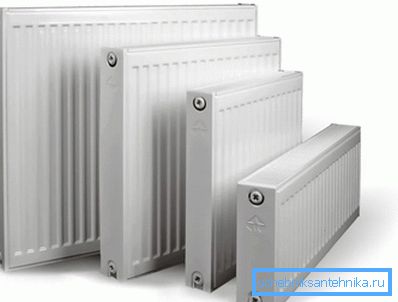
Steel panel radiators are not only effective, but also an inexpensive way to organize heating. However, such devices are often installed in autonomous climate systems, as they are sensitive to the chemical and physical composition of the coolant.
Tubular
In this case, instead of steel sheets, pipes of the same material are used, welded together in designs of various shapes and sizes. The process of their manufacture is somewhat more complicated than the previous version, and therefore the cost is higher.
Note! Unlike most other radiators, here you can’t arbitrarily add or remove sections to increase or decrease the power of the device. It is necessary to immediately calculate the need for heat and buy equipment of a specific size.
Technical characteristics of tubular radiators are as follows:
- working pressure - from 6 to 15 atmospheres;
- power generation - from 1.2 to 1.6 kW;
- the maximum temperature of the water flowing through them is up to 110 degrees Celsius;
- the acidity level of water is from 8 to 9.5 units.
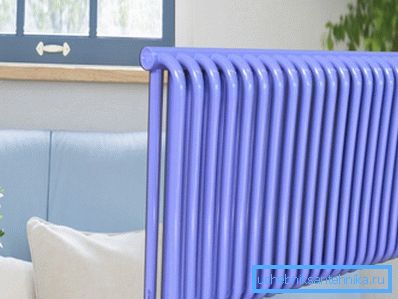
Devices sold in building supermarkets are of several kinds, which are labeled with numbers: 10, 11, 21, 22, 33, and so on.
Read this label should be as follows:
- the first digit in the number is the number of steel panels;
- The second digit in the number is the number of convector gratings.
Advantages and disadvantages
The advantages of using panel steel batteries include:
- low inertia - batteries quickly give off heat that comes with hot water, but at the same rate and cool down when the coolant supply is stopped;
- high heat emission - almost all the energy supplied to the battery is transferred to the surrounding air, unproductive losses are minimized;
- small internal volume - This allows you to design heating systems with a small amount of coolant, which affects the efficiency (to heat less water, less gas or electricity is needed);
- low price - these devices are the most inexpensive option among all radiators;
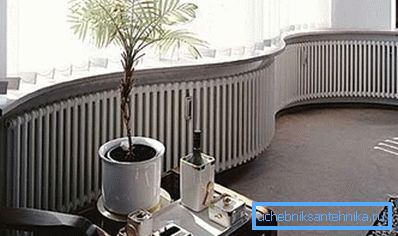
Not to mention the shortcomings, some of which exclude the use of steel heating panels in apartments, where the flow of coolant in the heating system is centralized:
- Such batteries can not be left without water poured into them, otherwise the oxygen in the system will lead to the formation of rust.
- Radiators made of steel very poorly tolerate hydraulic shocks that occur when the heating system is filled with liquid.
- Convection movement of air, organized by such batteries, leads to raising dust in the room.
Aluminum heating radiators
Made from aluminum. Like the previous version, they can be used only for houses and apartments with autonomous heating systems, since the coolant that flows in urban pipes leads to their complete destruction from corrosion within 3-4 years. In addition, they are damaged with a significant increase in pressure and water impacts.
There are the following types of aluminum radiators:
- cast;
- extrusion
Cast
Produced by pouring molten aluminum into special shapes. They have strong walls and wide channels that allow a large volume of fluid to pass through. These products are sold in separate sections, which allows you to independently assemble a battery of the desired power.
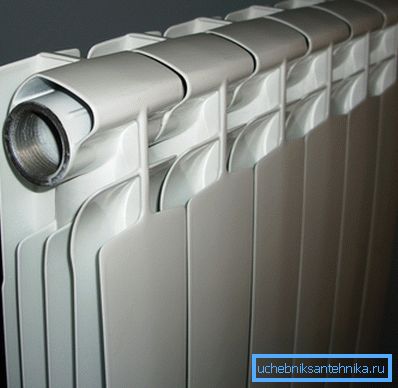
Extrusion
A simpler method of making aluminum radiators. In this case, each radiator is extruded from the workpiece using a special unit - an extruder. The water distribution manifold may be made of silumin.
Note! A feature of this kind of radiator is the inability to add or remove sections, increasing or decreasing its capacity.

Advantages and disadvantages
The advantages of aluminum devices for space heating are as follows:
- low weight - for mounting on the wall do not require massive brackets;
- high heat transfer coefficient - among all existing types of radiators, aluminum models are leaders in efficiency);
- low inertia - after a few tens of minutes after switching on the battery will heat the room (this also contributes to the special form of the heat exchanger, thanks to which air convection is organized);
- profitability - they effectively consume the coolant and can be equipped with thermal valves that increase or decrease the temperature of the battery, depending on external conditions;
- Attractive design - radiators are already covered with special powder paint, which protects the metal from damage and makes it easy to clean it from dust.
The negative side of using aluminum batteries:
- relatively short lifespan - about 15 years;
- strong susceptibility to corrosion (especially if a chemically “dirty” liquid flows in the heating system);
- the tendency to "airing", which forces from time to time to bleed air or install automatic air valves;
- the possibility of leaks between the individual sections of the device;
- tendency to destruction during strong pressure drops in the heating network.
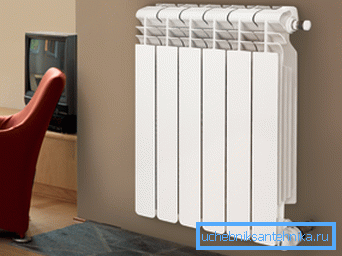
Instructions for the arrangement of heating networks recommends the following technical parameters of the coolant for systems with aluminum radiators:
- pressure from 6 to 16 atmospheres;
- power of one section from 80 to 200 watts;
- fluid temperature - up to 110 degrees;
- water acidity level - up to 7 units.
Cast iron heating radiators
Such products are made by casting and are divided into groups not by production technology, but by appearance.
You can choose one of two options:
- modern style batteries;
- "Retro" radiators.
Modern
These are standard radiators, which are used to seeing everything in apartment buildings built at the end of the last century. Modern models have flat facades that facilitate maintenance and a more sophisticated appearance.
Batteries have an increased service life (more than half a century), are easy to install and cheap. In addition, they are most suitable for installation in apartments connected to the central heating networks, since the composition of the coolant has virtually no effect on their strength, durability and quality of work.

Retro
Cast iron batteries in the old style are not so much heating devices, as elements of the interior - its highlight or an exclusive accessory. They are made by the method of artistic casting and decorated with various patterns. Each of the radiators is truly a work of industrial art.
But such luxury cannot be cheap. Such battery models are very expensive. The price is influenced not by technical characteristics, but by artistic value.

Advantages and disadvantages
Positive aspects of using cast iron:
- long service life - about 50 years;
- resistance to corrosion - cast iron is almost indifferent to the increased content of acids and alkalis in the coolant;
- the wave method of heating (as opposed to convector) - not only air is heated, but also objects in the room, which makes it possible to effectively heat rooms with high ceilings;
- large inertia - after cessation of coolant supply, radiators from cast iron remain hot for a long time;
- low cost
Cons installation of cast iron batteries:
- long warm-up time after the system is commissioned;
- cumbersome and large mass, which complicates the installation and transportation of batteries;
- the need to use a large amount of water in the heating network;
- fragility, due to which the battery can be destroyed as a result of a sharp increase in pressure inside the climate network
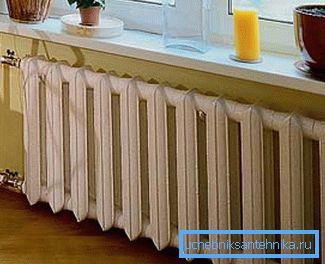
Bimetallic heating radiators
These devices combine the advantages of steel batteries and aluminum radiators. They consist of a metal frame and an aluminum heat exchanger arranged to circulate the air in the room.
Water circulates through the steel tubes of the frame without contacting aluminum, and it already transfers heat to the air in the room. Thus, maximum efficiency is achieved.
Bimetallic radiators can be installed in any heating systems. Their only drawback is the high cost.

Conclusion
The considered types of radiators for heating are used most often. However, this is not an exhaustive list. There are also copper batteries, combined heaters, and so on (find out here how to determine the required power of radiators).
You can learn more about them from the video posted in this article.